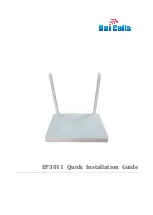
Page 11
1.9 Fuel supply - general
The Suspended Oil fired Unit Heater range are all manufactured and pre-set for use with either 28 second or 35
second gas oil delivered to the burner via a suitable piped system from the oil storage tank.
WARNING
Galvanised or plastic pipe work and fittings must not be used. (see BS 5410 Part 1 1997)
The constraints of the application will, to a large extent, determine whether it is preferable to use a single pipe gravity
feed system, or whether the two pipe pumped system is more appropriate.
Where more than one appliance is to share a common supply it will be necessary to use a pressurised ring main
system.
1.9.1 Fuel
In order to promote trouble free operating it is necessary that the oil within the storage tank and oil line does not fall
below the cold filter plugging point (cfpp), in this country and with class D fuel (also referred to as gas oil). The critical
temperature is -4°C for this summer grade. The cfpp critical temperature for the winter grade is -12°C. If summer
grade fuel is stored for winter use in areas prone to severe frosts and low temperatures it will be necessary to insulate
or even heat the supply tank and pipe work.
The fuel supplier should be contacted prior to installation so that any requirements concerning delivery,
transport, storage and use can be addressed before work commences.
WARNING
The inlet pump pressure must not exceed a maximum of 0.4 bar, this is because beyond this point gas is
liberated from the oil.
1.9.2 Storage tank
An externally painted steel storage tank to BS 799 part 5 1987 or a medium density polyethylene oil tank OFTEC
certified to OFS T-100 may be used. Local, national, European and fire regulations must also be complied with and
must include:
•
A fuel level gauge (not made from glass) a vent pipe with a diameter greater than that of the filler and featuring a weatherproof termination.
• A sludge valve.
• An outlet valve situated at the opposite end of the tank to the sludge valve.
•
A filler pipe connection situated at the opposite end to the outlet valve.
The size of the storage tank must take account of the estimated consumption and any quantity price breaks offered by
the oil supplier.
It is preferable to install the tank outside, however, if this is not practicable and the tank has to be installed indoors
advice must be sought about its siting, especially so far as fire regulations are concerned.
If a separate fire resistant chamber cannot be provided for indoor installations, a catchment pit with a capacity 10%
greater than that of the storage tank must be provided
Storage tanks can if necessary be sited on a roof, but this is subject to special regulations as well as local authority
approval and compliance with fire regulations, reference to BS 5410 part 2 1978 & part 1 1997 is strongly suggested.
It is advisable to leave the tank unpainted on the inside, but to paint the outside with a proprietary grade of anti-
corrosive paint.
WARNING
A galvanised or open topped tank is strictly not allowed.
All oil storage tanks require a bund
The Control of Pollution Regulation (Oil Storage) 2001 should be consulted prior to installation.
Содержание OUH 100
Страница 46: ...Page 46 Notes...












































